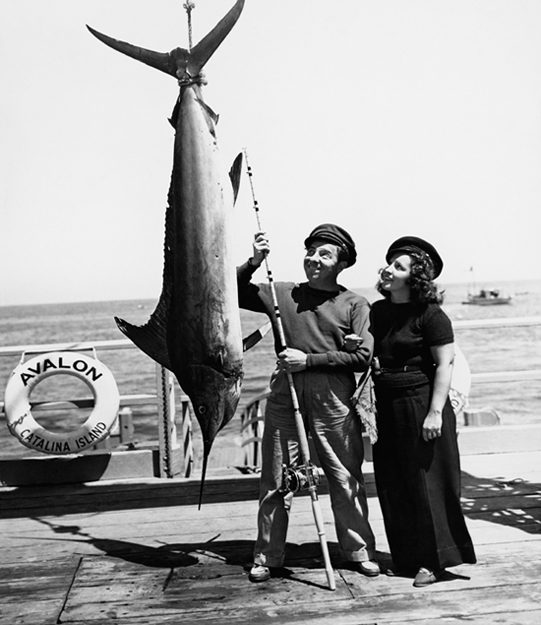The Billfish Story


The Billfish Story
SWORDFISH, SAILFISH, MARLIN, AND OTHER GLADIATORS OF THE SEA
Stan Ulanski


2013 by the University of Georgia Press
Athens, Georgia 30602
www.ugapress.org
All rights reserved
Designed by Erin Kirk New
Set in 10.2/14 ITC New Baskerville
Printed and bound by Thomson-Shore, Inc.
The paper in this book meets the guidelines for
permanence and durability of the Committee on
Production Guidelines for Book Longevity of the
Council on Library Resources.
Printed in the United States of America
17 16 15 14 13 c 5 4 3 2 1
Library of Congress Cataloging-in-Publication Data
Ulanski, Stan L., 1946
The billfish story : swordfish, sailfish, marlin, and other
gladiators of the sea / Stan Ulanski.
pages cm
A Wormsloe Foundation nature book.
Includes bibliographical references and index.
ISBN 978-0-8203-4191-0 (hardcover : alk. paper)
ISBN 0-8203-4191-6 (hardcover : alk. paper)
1. Billfishes. I. Title. QCL638.I88U43 2013
597.78dc23
2013014747
British Library Cataloging-in-Publication Data available
ISBN for digital edition: 978-0-8203-4633-5
Contents
Illustrations
PHOTOGRAPHS
FIGURES
MAPS
TABLE
COLOR PLATES
(following page 88)
Acknowledgments
Almost twenty-five years ago, I caught my first billfish, a blue marlin, in the Gulf Stream waters off North Carolina. By marlin standards it was not a huge fish, probably topping out at approximately three hundred pounds, but its tenacity, power, and jumping ability made a lasting impression on meleading me on a path of discovery and angling adventures that I continue to pursue.
I am particularly grateful to Laura Sutton, former acquisitions editor at the University of Georgia Press, who from the start allowed me to express my passion about billfish through her support of this book. As time has gone by, Regan Huff, also of the University of Georgia Press, has continued to efficiently guide the project through the maze of reviews and revisions.
Any discussion of billfish should be rich with images. All billfish paintings here are by Duane Raver, who is most generous in sharing his detailed illustrations of marine life. I was fortunate to make the acquaintance of Tom McMurray, who graciously allowed me to use many of his dynamic white marlin and billfish tournament photographs. I hope you enjoy them as much as I have. Rebecca Bunker used her drawing prowess to craft the figures, which add depth to the book.
I extend my thanks to Ron Presley and an anonymous reviewer for their very insightful and detailed comments on the manuscript, and to Stephen Barnett, who took on the task of reading, editing, and honing a manuscript that in many ways lacked cohesiona job well done.
And finally, I am indebted to the many anglers; captains, in particular Dale Britt, who welcomed me aboard his boat Sensation; conservation leaders, with Ellen Peel of the Billfish Foundation leading the way; mates; and researchers whose enthusiasm for these magnificent creatures is infectious.
The Billfish Story
Introduction
Roaming the blue waters of the Atlantic Ocean are predators at the apex of the oceanic food chainthe billfish. These species include the sailfish, spearfish, white and blue marlin, which are all part of the same biological family, Istiophoridae; and the swordfish, the only member of the Xiphidae family. Probably no other feature better defines these fish than their long, pointed bills, which have been used by swordfish to pierce the hulls of unsuspecting ships and by sailfish to slash through schools of panicked baitfish.
Noted for their speed, size, and acrobatic jumps, billfish have inspired a broad spectrum of society for decades, from scientists to writers to big-game anglers. As far back as antiquity, Aristotle observed swordfish that annually migrated into the Mediterranean Sea, naming them xiphias (the sword). Bernard Lacpde, a French naturalist, systematically studied the blue marlin as early as 1802. Zane Grey, known mainly for extensive chronicles of the American Old West, detailed the use of light fishing tackle to catch sailfish off the Florida Keys in Fishing in the Gulf Stream (1922). And Ernest Hemingway drew on his numerous fishing adventures to craft his acclaimed novel The Old Man and the Sea (1952)an epic tale of an old Cuban, Santiago, battling with a marlin and with his obsession with proving himself a worthy slayer of such a grand beast. Present-day anglers can definitely associate with Santiagos compulsiveness as they passionately pursue the elusive billfish. With the advent of big-game fishing at the end of the nineteenth century off of Catalina Island in California, numerous tournaments along the eastern seaboard now attract hundreds of anglers. The annual Ocean City White Marlin Tournament, for example, pits the best anglers along the mid-Atlantic coast against one another in an adrenaline-fueled, high-stakes, and high-dollar competition.
As the subtitle tells you, this book relates a story of a unique group of marine organisms, the billfish, and the people who have formed bonds with themanglers, biologists, charter-boat captains, and marine officialsfrom their study, pursuit, and conservation efforts of these fish. (While two other billfish, striped and black marlin, are found in Indo-Pacific waters, my focus lies primarily on Atlantic billfish.)
My main goal is to meld part natural history of billfish, part angling adventure, and part cultural examination into a straightforward primer to Atlantic billfish. This holistic approach to the subject is intended to lead you, the reader, on a journey of discovery, an odyssey during which the billfish becomes a blank slate upon which to project discussions of angling traditions, limits of scientific research, and economic relevance.
As I hope this book makes clear, the anatomy and physiology of these fish are both unique and complex, allowing them to survive and hunt in their vast watery environment. Blue marlin, the largest of all the billfish, reaching weights of over one thousand pounds, migrate long distances, powered by a combination of oxygen-fueled muscles and a sickle-shaped tail fin. The large, bulbous eyes of the nocturnal-feeding swordfish allow it to detect prey even in the dim reaches of the abyss. Able to elevate its brain temperature ten degrees above the ambient water temperature, the swordfish can probe depths beyond the reach of other billfish. Vertical bars of pale blue spots along the flanks of a sailfish, one of the swiftest fish in the ocean, flash iridescence as it pursues a school of fleeing sardines.
Over the years, researchers have developed a bewildering array of sophisticated instrumentation to systematically study billfish. Spatial and temporal movements of these pelagic wanderers are starting to reveal themselves through the use of electronic tags, which are attached externally to the fish, release (pop up) at a programmed time, float to the surface, and begin the transmission of data (swimming depth, water temperature, body temperature, and ambient light) to a satellite.
Next page








